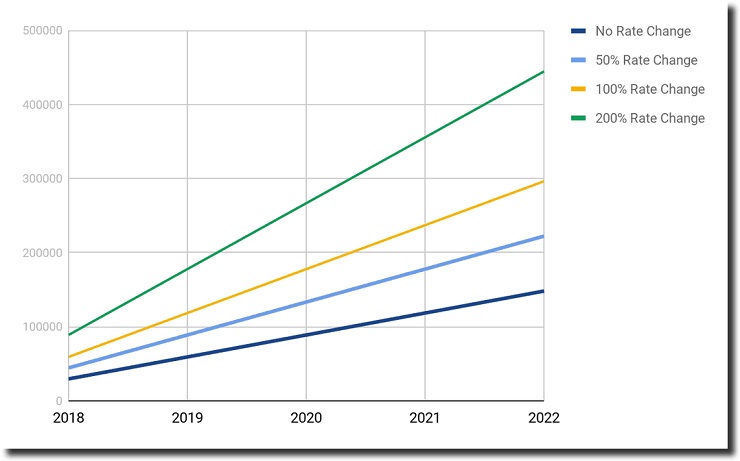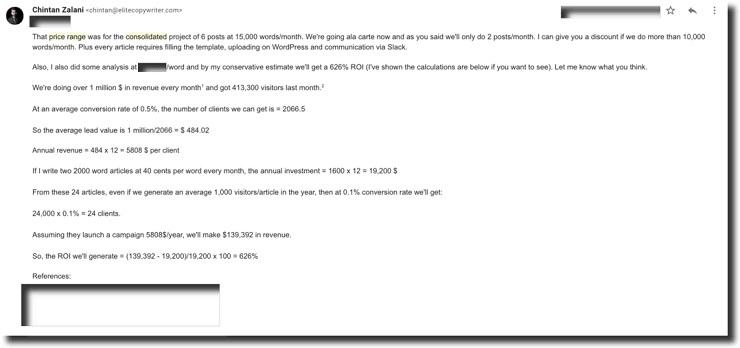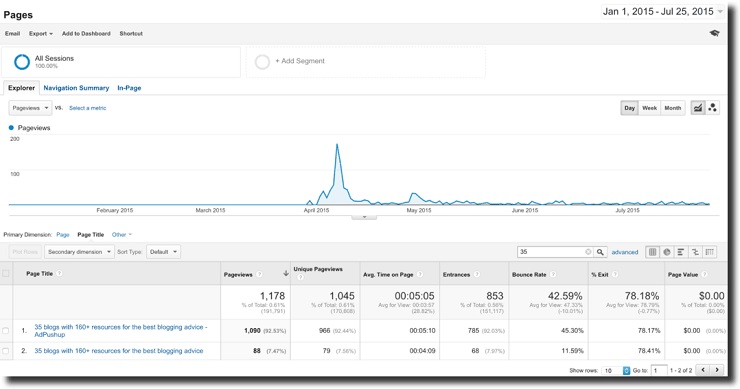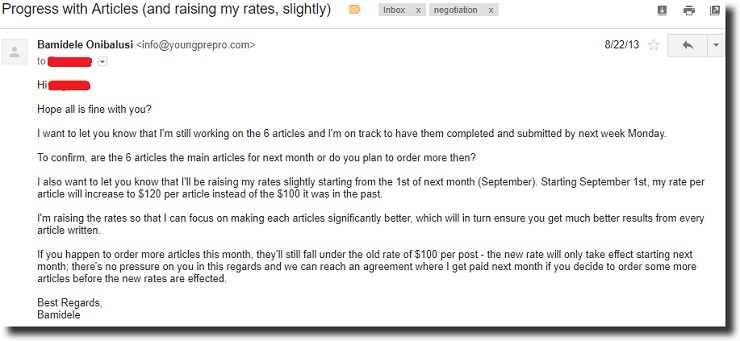Let me tell you a little secret. Every pro freelancer had fears and insecurities surrounding their skills and services. None of your freelancing heroes are immune to pressures of human nature.
Guess what though?
They overcame these fears and raised their freelance rates, anyway.
I know it’s tough to find good, specific how-to tips on raising rates for the first time. So I waded into the trenches for advice from professional writers, designers, content marketers, and programmers.
Here’s some wisdom from the pros on how to approach increasing your rates as a beginner. After you have devoured the advice from the experts, there’s a bonus waiting at the end of the article for you. Don’t miss the opportunity to generate more revenue – scroll till the bottom!
Table of Contents
Why It’s Important to Raise Your Freelance Rates
Begin by Building a Strong Business Foundation
One Thing You Must Do Before Starting With a New Client
How to Raise Your Rates With Existing Clients
Generate More Revenue Per Client Without Raising Freelance Rates
Don’t Overthink Raising Your Freelance Rates
BONUS Website Review: What’s Preventing You From Raising Your Freelance Rates?
Why It’s Important to Raise Your Freelance Rates
For starters, your time’s worth more than you’re currently charging. Based on reports like Payoneer’s 2018 Freelancer Income Report, it’s likely worth over one and half times the current rates you charge. However, fear may be overpowering you, which can cripple your ability to get ahead in your business. The result is you keep slogging for clients and get underpaid for it.
In the first few months of your freelancing business, you may experience tremendous growth, but that may be only because you are charging low rates. This is not ideal, because the opportunity cost of waiting is seriously high.
Let’s consider you are like the average freelancer working in 2018: You charge $19 an hour and bill 30 hours a week.
In the current year, you’ll make $29,640 and earn a cumulative income of $148,200 over the period of next five years. Now, let’s project your income for the next five years with an increase of 50% in your rates. Then, increase it by 100% and 200% respectively.
- A mere raise of 50% in your rates can net you an additional $14,820 this year and an extra $74,100 over the course of five years.
- A 100% rate increase can net you an additional $29,640 in 2018 and an extra $148,200 over the course of five years,
- Finally, a 200% raise in your rates can net you additional $59,280 in this year and a whooping $296,400 in the next five years!
Woah. Even a below average raise of 50% can net you 74 grand in the next five years.
Do you feel the urgency to raise your freelance rates, already?
EXCLUSIVE FREE TRAINING: Successful Founders Teach You How to Start and Grow an Online Business
Begin by Building a Strong Business Foundation
Most freelancers start with minimal prior experience and a thin portfolio. Hence, your initial months of freelancing invariably involve hard work to get your business in order.
To raise your rates, you need to:
- Prove your skill set
- Build leverage
To obtain both of these ingredients, you need to hustle. You need to work on sizeable projects to build an impressive portfolio that shows your skills. Simultaneously, you need a few consistent clients that guarantee you a reliable income and give you the advantage to raise your rates with the newer ones you onboard.
How can you approach the initial period of hustle?
Adopt a simple mindset like Jacob McMillen (copywriter and content strategist) had at the beginning of his career: “If I have an available hour and somebody is willing to pay me to write something, I’ll do it.”
Here’s how it worked practically to affect Jacob’s income:
I was building out the SEO for my website, so I knew that once I got to the point where more people wanted my work than I had available hours for, I could then set a higher price to weed out the bottom paying gigs and still fill my hours. So let’s say my initial price was around $0.10 per word, which I think is probably ballpark. Once I had my schedule filled at $0.10 per word, then I simply started quoting $0.15 per word when new leads would come in.
Indeed, he split his clients between short-term and long-term to systematically raise his rates.
For short-term clients, I raised my rates over time simply through demand. Once I hit the point where I am constantly filling my availability at my current rate, I raise my rates for new clients until I am once again filling my availability at the new rate, and then I raise them again, and so on. I can do this because I have consistent lead channels bringing me new clients each month.
Most of the other pros I spoke with in my research had a similar strategy. Here’s what content strategist and writer Sophie Lizard had to say: “The very first time I raised my rates was in between clients, just by quoting a higher rate to my second client than my first client.”
Freelance writer Bamidele Onibalusi also took a similar “two-pronged approach.”
I first applied the increased rate to new clients. This meant I was charging existing clients less than I charged new clients. I did it to avoid being in a difficult situation should the raise not work with existing clients. Once I’ve had a few new clients paying my new rates, and I could afford to lose the clients who didn’t pay the new rates, I then tell existing clients about the rate increase. Things were still very fragile then. Being sudden could leave me without clients, so I had to be careful.
Writer Carol Tice also recommends raising rates with new clients first, as they’ve never paid the old rate.
Can you spot a repetitive narrative in the above cases? All freelancers worked on generating a flow of prospective clients. The challenge is that beginner freelancers rarely have a reliable source of generating leads for their services.
Now, a few common strategies to work around this include working on your website’s SEO, guest posting on authority websites where your clients hang out, and running targeted ads.
As you might know, though, your highest-quality leads are the referrals you receive from existing clients.
Early leads for my writing business were generated by delivering stellar quality writing to my clients. Providing great work and getting those clients to endorse you is a great way to build trust with prospective clients. Plus, isn’t it lovely to get such emails from your existing clients (even without your request)?
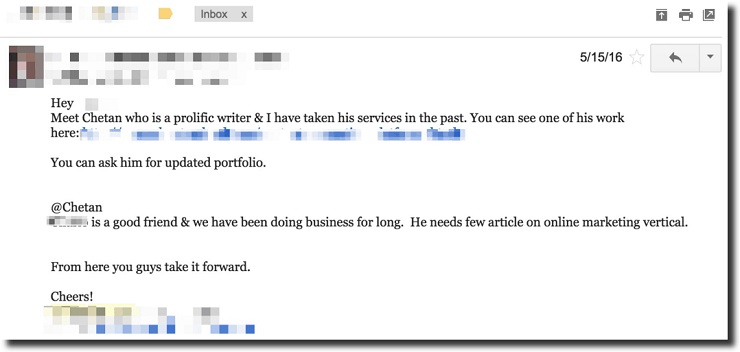
The above email resulted in my highest paying gig to date.
Furthermore, in the beginning, I highly recommend indirect ways to add value to your prospective clients. That might mean suggesting design/development updates for their website during your roadmapping session or in-project communication. Or it could mean simply featuring them on your blog to improve your reputation.
For one example of a time I landed some high-quality new leads, I compiled a list of thought leaders in my industry in an article and informed all of them about it through an email. It resulted in many prospects connecting with me, inquiring about my services, and ultimately, generated over $20,000 in revenue.
Content marketing consultant Ryan Robinson also recommends a cold emailing strategy to gain the attention of prospective clients.
Look at the email below in which Ryan reached out to a startup founder. He asked for a quick quote to feature him on his blog and ended up netting him over $50,000 in revenue from freelance projects, as he grew the relationship to last a few months down the line.
Having a strong business foundation also involves actively building your network by participating in niche communities on Facebook, LinkedIn, Slack, and elsewhere. Expert B2B Freelance Writer Elise Dopson gets the majority of her leads this way. It’s especially helpful in the lonely pursuit of freelancing.
I get the majority of freelance leads from other people in my network. I’m active in various Slack communities, and even run one specifically for freelancers, where we have a #jobs channel to pass-on work/look for people to refer. It’s a great way to build friendships (since freelancing can be extremely lonely), while also being in with the chance of getting more work.
One Thing You Must Do Before Starting With a New Client
Brennan Dunn, the founder of Double Your Freelancing, teaches repeatedly that you can justify an increase in your freelance rates by anchoring it against the value your services bring to a business. It’s all about generating a healthy ROI for your client.
In rare cases, you might find relevant company revenue figures. Then, you can use industry averages to calculate the value you generate. Here’s one such email I used to justify my rates to a client.
Unfortunately, I failed at convincing him to pay my desired rate, because I calculated the ROI on the revenue instead of profit.
Bummer, I know.
However, I did negotiate a higher rate than the one he originally insisted on paying.
In most practical scenarios, you will find it difficult to find the revenue of a company. However, before you begin working with a client, you can request performance metrics tied to your services.
Writer Lucy Damasceno first worked on getting long-term clients that request some of her services monthly. Then, she asked for a raise because she had stats and results to show.
“There were Google Analytics reports proving the time visitors spent reading my articles, along with a low bounce rate and increasing conversions,” she says.
Note that requesting access to sensitive business data requires you to establish trust with a client. Lucy had a solid relationship already built, as she was in touch with most of her clients on a daily basis. However, she doesn’t shy away from requesting access to stats at the beginning of the engagement itself:
I talk to them about data even before day one, while we are discussing the job. Of course, they don’t disclose everything from day one. But, I would say that, on average, I start getting reports after 3 months of regular work.
What kind of data does she request?
“I always request, not full access to Google Analytics (GA) and Search Console, but to relevant reports. Some clients do give me full access, though – probably because it’s easier for them.”
Here’s how Lucy clarifies her request for data and reports:
“My writing is 100% tailored to my client’s target audience. I also repurpose a lot of content. And for both reasons, I need reliable data.”
Occasionally, you can get away with requesting analytics after you have done your job. When I requested a raise and a review of my performance, I was greeted with the following GA screenshot.
However, my relationship wasn’t at the stage where I could justify a raise, which shows the importance of working long term.
EXCLUSIVE FREE TRAINING: Successful Founders Teach You How to Start and Grow an Online Business
How to Raise Your Rates With Existing Clients
Once your business has reached sufficient demand, it’s time to increase your fees with existing clients. Jacob McMillan recommends you provide about one to two months to your monthly client to stomach your raise.
Here’s how the process might look:
First, you need to consider personalizing the percentage of your raise for every client rather than shooting for the same multiplier. Carol Tice recommends going for an increase of about 5% to 10% as opposed to 50% or a 100%.
For Lucy Damasceno, the percentage of the raise varied from 30% to 100%. “I approached them one by one, from the most to the least likely to agree with the increase. This way I could learn from my mistakes without losing all my clients in one go. Thankfully, I got positive replies from all of them.”
Now, let’s look at how to inform your clients. It’s scary to type the email to announce your raise, but Sophie Lizard just dropped it as a “future fact.”
How I raised rates for the first time with the *same* client was simple. I emailed the client and explained that:
- A) my rates would increase on a specific date soon
- B) if they were content to keep going at the new rate, they didn’t need to do anything
- C) if they wanted to discuss the change, I’d be glad to hear their comments or questions.
Did she even justify her increase?
I didn’t present a reason for the raise within the email—I just stated my rate change as a future fact and made accepting it as low-effort as possible. Basically, I relied on the fact that the client was very happy with my work and wouldn’t want to start fresh with a different writer.
Indeed, Sophie uses a similar approach today, although she also reminds the clients of successes that she helped to create for the client.
Reuven Lerner, a programmer and a man of many talents, approached his price negotiations differently. For a very, very long time, Reuven didn’t really raise his rates. He was satisfied with what he was being paid. He just charged a bit more with new clients. However, when he did raise his rates, it was on a “one-off basis, rather than an across-the-board-change.”
“I would explain that my services are more in demand and that I’m raising them as part of that,” he said.
A caveat is that he was undercharging them anyway. “They generally understood, and in retrospect, that’s probably because I wasn’t charging them nearly enough to begin with!”
If you’re confused about how much you should raise your rates, Reuven offers the following formula:
I first raise rates on new clients for a year. If I’m not sure by how much I want to raise them, I experiment on very new clients, giving them a much higher rate. If/when they freak out, I then say that I’m willing to go down a bit. After 3-4 such conversations, you can figure out what the maximum is that people are willing to pay. I then make that my new, standard rate for about a year.
However, Jacob makes a compelling argument on how quoting a high rate is equally likely to result in you losing money. “When a potential client shows up in your inbox, you don’t know their budget. Quoting $5,000 to a $3,000 budget loses you $3,000. Quoting $5,000 to a $10,000 budget loses you $5,000.”
How to solve this dilemma? He recommends you go by what you want to be paid for a project, which is informed by market rate and demand.
If I’m really busy already, I might quote a bit higher than I normally would because my margins will need to be great for me to want to work more that month. If I’m in a slow month, I might quote a bit lower, because I’d rather get the guaranteed money than risk not landing the sale.
Similarly, Elise Dopson also does not have a set process for raising rates with a single client. Here’s how she tries to gauge if her rates are too low:
I up my quotes by 15-25% for every new enquiry that I get, and once a client has been landed on that rate, increase by the same amount again—so I may quote $500 for three enquiries, but if one accepts, the next batch of enquiries will be quoted at $575. It’s the best way I’ve found to make sure you’re not undercharging, and get a good indication of whether your rates are too low (which they often are).
When it comes down to raising your freelance rates, you need to position yourself and communicate well.
After a year or so has passed, here’s how Reuven Lerner would typically communicate his increase in rates. “I really value our relationship, so much so that I’ve grandfathered you with my old rates for the last year. But you’re the last client to be paying this amount, and I’m afraid that the time has come to raise them.”
Mostly, it works well!
“They like hearing that they have been paying less for a while, and they like hearing that I value the relationship. The only pushback I typically get is that they ask I not raise rates for a while in the future.”
Generate More Revenue Per Client Without Raising Freelance Rates
There’s another strategy to extract more revenue from your existing clients.
If you carefully analyze the needs of your existing clients in relation to your offerings, you’ll likely discover a few additional business needs you could help them meet.
Now, your job is to create a product that’s more valuable to your client. If you take additional responsibilities off your clients’ plates, they’ll likely be happy to pay you more. It’s the classic upselling strategy that the best brands of the world employ.
For his long-term clients, Jacob McMillen continuously looks for such upselling opportunities. “I’m always looking to evolve writing gigs into content marketing gigs, where I’m running the strategy, promotion, SEO, etc. in addition to the writing.”
At Content Bistro, Mayank and Prerna do something similar. They started with reasonably priced packages and offers to get more clients and build street cred. To consistently increase their rates, they like to approach this from the perspective of “skill development.”
For instance, we started with offering done-for-you social media services and then added article writing, blog post writing, SEO services, marketing services, data analysis and much more. We also started to package and productize our services so we could charge more and also have long-term relationships with our clients.
What’s the key to not receiving pushback on price from a repeat client?
“Currently our specialty is Conversion Copywriting, CRO, launch, and marketing strategy services. We continue to offer more value to our clients every time they come back to us, and hence we’ve never had pushback on price.”
What if You Run Into Objections to Your Increased Rates?
One way to avoid tension around raising rates is by quoting a flat project-based fee that accounts for your rate preferences. Janelle Allen, who helps businesses create custom online courses, swears by this technique. “I haven’t had friction when raising rates. I generally charge a flat project fee, instead of hourly, so I just build my preferred rate into my project fee.”
She feels the key to eliminating friction is “to educate and add value before you discuss price.”
However, it’s inevitable. Some of your clients won’t be happy to learn about your increased rates.
Can you still work with them?
Yes. One way to deal with objections is by negotiating around the scope of the project, instead of the rate. Janelle does it, and I have done the same, keeping my pay the same but decreasing the tedious workload of uploading posts on WordPress.
Years ago, Bamidele Onibalusi used the following email message to announce his raise.
“The client was doing six articles a month—he accepted the increase and reduced it to five articles a month to keep within budget. Still a win for me since that’s one less article for the same total pay.”
Bamidele feels some essential elements led to the acceptance of the above proposal:
- I avoid making the raise too high—like in this case. Most clients will easily stomach a 20% raise over a 50% or more raise.
- I gave a reason for the raise—focusing on making the article better so that they can get better results. At other times, to justify the increase, I’ve mentioned the fact that I have so much demand and would eventually have to drop them at the current rate to serve other high-paying clients.
Caveat: Note that making an article “better” as Bamidele suggests is a tricky strategy. It could raise objections in the mind of the client on why you were not doing your best work in the first place.
However, you need to position how your “extra” services will help your client drive better business results. In case of blog posts, writing “better” could mean adding more screenshots, references, and anything that adds more value. The associated business metrics could include higher website engagement, better time on page, and improved search rankings.
For example, a client was offering me $150 for writing detailed blog posts at 1,000+ words. I requested to renegotiate on the price, as it took a lot of time to write such detailed content. I offered him my long-form content service that’s proven to work better in search engine results.
In the email, I also showed proof of how such content has done well for my past clients.
After a couple of email exchanges, we settled on $200 per piece.
I gave them some time to prepare for the raise. In this particular case, it was less than two weeks, but I gave them time. Some people suggest a month or two of notification. Regardless, a sudden ‘I have raised my rates with immediate effect’ notification to your clients will probably cost you the relationship.”
The last option, if you still feel unsatisfied with pushback you’re getting, is to walk away from the deal.
As your time and availability are limited in supply, it makes sense to work with clients you are happy to work with and who pay you well. In fact, I built my entire business by applying Pareto’s principle: 20% of clients generate 80% of the revenue. So I focused on providing high-quality services to this 20% clientele and discarded the rest.
Don’t Overthink Raising Your Freelance Rates
Remember, your clients understand this is a business relationship! It’s not personal. Reuven offers the perfect piece of parting advice.
When you’re new at consulting, telling someone how much you want to charge them can be scary. You cannot believe that someone is willing to pay you (and often pay a lot) for your services!
But raising your freelance rates?
That’s even harder because you feel like:
(a) maybe they’ll leave me, giving me zero instead of more, and
(b) maybe they’ll see this as a betrayal of some sort.
Neither is the case.
It’s a business relationship, and they realize that sometimes prices have to go up.
BONUS Website Review: What’s Preventing You From Raising Your Freelance Rates?
EXCLUSIVE FREE TRAINING: Successful Founders Teach You How to Start and Grow an Online Business
Are you the kind of person who contemplates adding a couple more projects to your portfolio before you feel “ready” to raise rates?
If so, I have bad news for you: You’re likely undercharging.
You’re worth MORE.
If you’re a consultant or a freelancer and struggling with raising rates, then share your website’s link below in the comments. For the first 15 people who comment, I’ll have a look at your website and suggest specific strategies on upselling, branding, positioning, and communicating your value that could help you raise your rates and generate more revenue.

